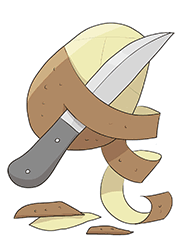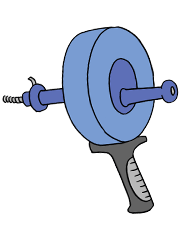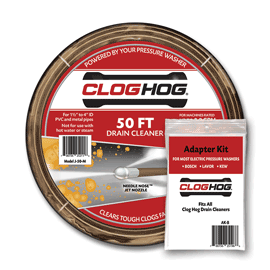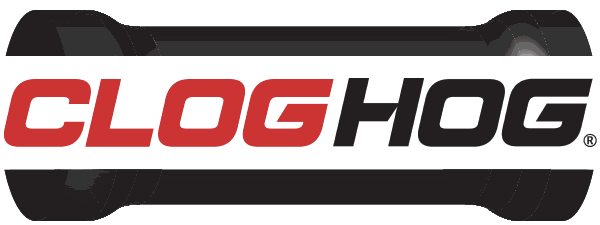Drain Cleaning Tips »
How Do I Unclog Food Residue?

To remove food residue that's clogged a drain, start with your easiest options first.
- First, try using a handheld drum auger to loosen, pull out or break apart any food debris that is stuck in the drain.
- A 25 foot handheld drum auger can be purchased for around $30.

- This is a good first choice, since the auger can break through many clogs that are in the sink's lateral drain line, and the spiral tip can often pass through the small-diameter traps and elbows in the line that runs from a sink to the main drain.
- To unclog a sink with a handheld auger:
- Read and follow the drum auger safety instructions, then put on work gloves and eye protection.
- Remove the sink stopper, if present, and then feed the auger into the drain by locking the cable, turning the drum in a clockwise direction, and then unlocking and feeding the cable as needed to pass the auger tip through elbows and obstructions.

- If you have difficulty passing the cable through the sink trap, it may be easier to place towels under the sink trap to handle any spills, remove the trap, and insert the auger directly into the drain opening underneath the sink.
- After you have inserted the drum auger all the way into the drain, pull out the auger cable as you feed it back into the drum. It may take several attempts before the sink drain is unclogged.
- Use extra caution when working on any plumbing fixture where chemical drain cleaners may have been used to avoid splashing liquid on yourself and surrounding areas.
- A 25 foot handheld drum auger can be purchased for around $30.
 Try using a sewer jetter if the food residue clog keeps coming back.
Try using a sewer jetter if the food residue clog keeps coming back.
- A Needle Nose™ drain cleaner is a sewer jetter with a tougher, braided steel jacket and a special compact nozzle tip that allows it to pass through almost as many drain elbows and transitions as a handheld auger.
- Important: you should try a sewer jetter only if you were able to insert the handheld auger its full 25 foot length into the drain. And, you should have an alternate, clogged drain opening available nearby in case the sewer jetter can't pass through any short-radius elbows close to the first opening you try.
 Unlike a mechanical auger, the sewer jetter scrubs the sides of dirty pipes and flushes out sticky residue so fewer clogs come back. You can see the differences between a mechanical auger and the sewer jetter as they both take on a sticky clog in this 2 minute video.
Unlike a mechanical auger, the sewer jetter scrubs the sides of dirty pipes and flushes out sticky residue so fewer clogs come back. You can see the differences between a mechanical auger and the sewer jetter as they both take on a sticky clog in this 2 minute video.- To unclog a sink with the Needle Nose drain cleaner:
- Put on fluid resistant work gloves and eye protection. Use extra care if you believe the drain might contain drain cleaning chemicals.
- Set up a bucket and towels under the sink trap to handle any spills, and then remove the trap.
 Make sure the work area is well ventilated. And, if you're using a gas-powered pressure washer, only operate it outdoors.
Make sure the work area is well ventilated. And, if you're using a gas-powered pressure washer, only operate it outdoors.- Connect the drain cleaner to your pressure washer trigger gun. Then, to avoid getting water on indoor floors, while you're outside check your trigger gun and supply hoses for leaks.
- Start your pressure washer, and then guide the nozzle about a foot into the drain opening before you squeeze the trigger to start the flow of water.
- After you have finished cleaning the drain, pull the drain cleaner out. Use care to release the trigger to stop the flow of water before the nozzle reaches the drain opening.
- Replace the sink trap, check for a water tight connection, and then remove the bucket and towels.
 If a large volume of food debris has reached the main drain and has clogged the plumbing fixtures in several rooms, you can try to break apart and flush out the clog from the main drain with a sewer jetter.
If a large volume of food debris has reached the main drain and has clogged the plumbing fixtures in several rooms, you can try to break apart and flush out the clog from the main drain with a sewer jetter.
- Important: you should avoid using a sewer jetter if you think that your sewer drain could have structural problems caused by foundation issues, or if you live in an older home that could have ceramic (clay) or Orangeburg (wood composite) drains.
- For detailed tips to clean your main drain with a sewer jetter, visit the unclog a main sewer drain tips page.
- If you're not comfortable performing any of these steps, hiring a good, licensed plumber could save you money in the long run. To find a good plumber in your area:

- Start by asking family, friends and co-workers to recommend a licensed plumber who has performed similar services for them.
- If you are unable to find a good recommendation from someone you know, search local directories like Google Maps, Yelp and CitySearch for licensed plumbers nearby who have good online reviews. Don't always trust reviews from individuals who published very few other reviews, or from people who give only positive reviews to everyone. Be aware that good service providers sometimes get a small number of negative reviews for reasons that might not be relevant to your situation. Look for a company with several reviews that tell a positive, believable story about repairs that are similar to yours.
- After you find one or more licensed plumbers who seem to have a good reputation, search online for the company name and the names of individuals at the company, if known. Take into account both the positive and negative information that you find about the company.
- Be aware that good plumbers sometimes have a backlog of several days during peak times when there are low temperatures, heavy rainfall or holidays. Sometimes heavy demand can be a sign of a company with lots of repeat customers.
If you have questions or comments please contact us.






